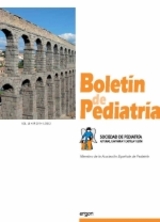Estado nutricional en pacientes pediátricos con fibrosis quística
D. González Jiménez , J.J. Díaz Martín , C. Bousoño García , M.F. Rivas Crespo , M.D. Acuña Quirós , S. Heredia González , A. Sojo Aguirre , A. LÁzaro Almarza
Bol. Pediatr. 2012; 52 (219): 14 - 18
Introducción y objetivos. La importancia de un óptimo estado nutricional en la fibrosis quística es bien conocida, ya que incide en la mortalidad y en la función pulmonar de estos pacientes. Nuestro objetivo fue evaluar el estado nutricional de una muestra de pacientes pediátricos con fibrosis quística. Pacientes y métodos. Estudio multicéntrico descriptivo y transversal, se reclutó en cinco hospitales universitarios nacionales, 109 pacientes con fibrosis quística sin agudización respiratoria, con edades entre 5 y 18 años. Se clasificaron según el índice de masa corporal en: desnutridos, normales y sobrepeso. Análisis estadístico: ANOVA de un factor. Pruebas post-hoc de Bonferroni. Resultados. La edad media fue de 12,65 ± 3,21 años, el 47% eran varones. Catorce pacientes (13%) estaban desnutridos, 89 (82%) tenían un estado nutricional normal y 6 pacientes (5%) presentaban sobrepeso. Su edad, distribución sexual, base genética son similares en todos los grupos; aunque la proporción de suficientes pancreáticos (3/6; 50%) fue superior (p = 0,003) en los pacientes con sobrepeso. Los valores medios de peso, talla e índice de masa corporal expresados como puntuación Z fueron: -0,62 ± 0,78; -0,20 ± 1,18 y -0,32 ± 0,84 DS, respectivamente. Si analizamos los distintos datos antropométricos según el sexo y edad de los pacientes no encontramos diferencias estadísticamente significativas entre los mismos. Conclusiones. A pesar de los avances en el tratamiento, un porcentaje no desdeñable de pacientes con fibrosis quística presentan desnutrición. Por otra parte, las pautas de estilo de vida actuales y el soporte nutricional agresivo, podrían suponer en un pequeño porcentaje de casos la aparición de problemas nutricionales por exceso.
Nutritional condition in pediatric patients with cystic fibrosis
Introduction and objectives. The importance of an adequate nutritional state in cystic fibrosis is well known and it is also known that it has an effect on the mortality and lung function of these patients. Our aim was to know nutritional status of a sample of pediatric cystic fibrosis patients.
Patients and methods. Descriptive cross-sectional study. 109 patients without pulmonary exacerbation, aged between 5 and 18, were recruited in five national cystic fibrosis units. Were divided into 3 groups according body mass index: malnourished, normal and overweight. Statistical analysis: oneway ANOVA, Bonferroni Post-hoc tests.
Results. The mean age was 12.65 ± 3.21 years, 47% were male. Fourteen patients (13%) were malnourished, 89 (82%) had normal nutritional status, and 6 patients (5%) were overweight. All groups had similar distribution by age, sex and CFTR mutation, although proportion of pancreatic sufficient (3/6, 50%) was higher in overweight patients (p=0.003). Mean weight, height and body mass index (expressed as Z score) were: -0.62 ± 0.78; -0.20 ± 1.18 and - 0.32 ± 0.84 DS respectively. We don't find differences in anthropometric data when we analyze by sex and age of the patients.
Conclusions. Despite advances in treatment, a significant percentage of cystic fibrosis patients are malnourished. Moreover, current lifestyle and nutritional support, could lead in a small percentage of patients the appearance of overnutrition problems.
Artículo completo (PDF) (109 kb.)
- Endocrino-Metabolismo
